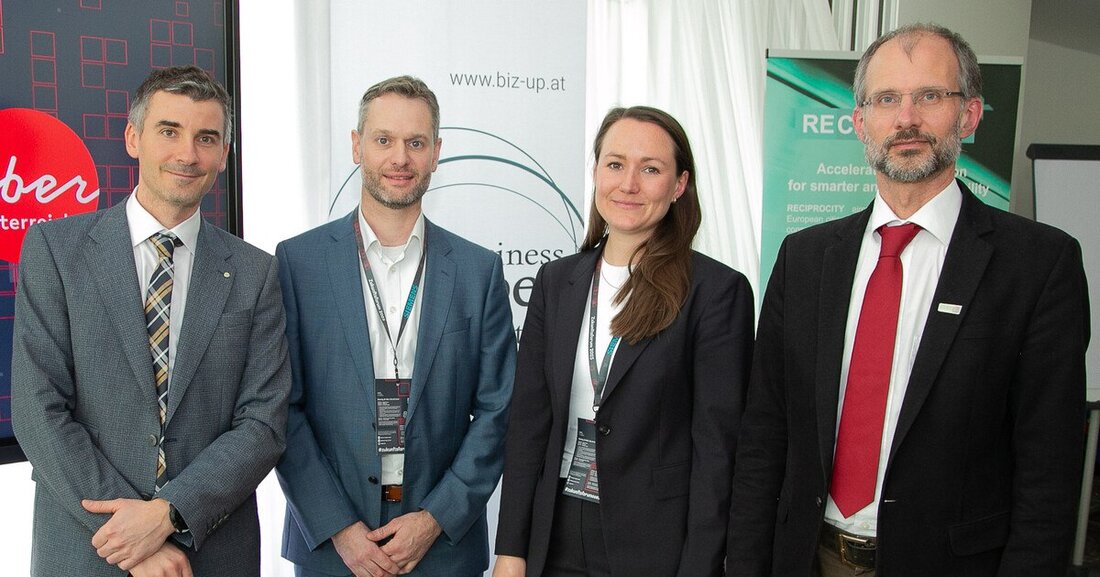Risks and opportunities of change
The focus of the Upper Austria Future Forum was on the end of combustion engines, fuel cells, green hydrogen and e-fuels.

Risks and opportunities of change
100 interested people accepted the invitation to the Oberbank Donau-Forum. Automobile cluster manager Florian Danmayr introduced the speakers. All lectures were about which technologies can be used to manage the transformation towards environmentally friendly, climate-neutral mobility. Anna Grimm from the Fraunhofer Institute for Systems and Innovation Research ISI in Karlsruhe showed with her studies, statistics and forecasts: There is no single solution. "The end of the combustion engine is not a competitive disadvantage for the European automotive industry, but rather the logical consequence of a decision that the car manufacturers have already made. The fact is that the OEMs have already committed themselves to battery-electric drives in their strategies."
The social aspect was highlighted in the discussion. Electric cars are currently still expensive and unaffordable for socially disadvantaged people. There is a risk that, before the combustion engine is phased out, large numbers of gasoline and diesel vehicles will be purchased before they no longer exist. Anna Grimm is convinced: "With new technologies, car manufacturers have always entered the upper class because the development costs have to be amortized. By 2035, car manufacturers will offer more smaller and affordable models." Jürgen Rechberger, responsible for the hydrogen division at AVL List GmbH, also agreed with this. However, he points out: "Electricity consumption will almost double by 2050 if we decarbonize all sectors. In Austria we will not be able to generate enough renewable energy and will therefore continue to be dependent on imports." His vision is for the industry to switch to green hydrogen. This is also useful in the transport of goods as fuel for airplanes, ships and heavy trucks that travel long distances. Rechberger sees little potential in private transport because the costs for hydrogen are too high. The issue of distribution is also a challenge: “We will have to transport the hydrogen overland using pipelines, just like natural gas and crude oil.”
Franz Winkler from HyCentA Research GmbH, the hydrogen research center at Graz University of Technology, also made a plea for hydrogen. He reported on pilot projects with hydrogen and fuel cell buses in Villach and Graz, which are already in trial operation. For Winkler, this is the technology of the future that can stop climate change: “It doesn’t matter where we use the hydrogen, the main thing is that we don’t produce any CO2!” He also made it clear that battery-electric vehicles have a worse CO2 balance over their entire life cycle than vehicles with fuel cell drives: “A study by the Fraunhofer Institute has also proven that battery-electric transport will not help us with climate protection.” Winkler's conclusion: "It's like first aid: the only mistake you can make is to do nothing!" Austria is in the fortunate position of being able to store hydrogen in empty natural gas storage facilities. Austria's first large-scale hydrogen storage facility will open on April 27th in Gampern in the Vöcklabruck district. Such large-scale storage systems are necessary to store the excess renewable energy produced in the summer for the winter.
Metals and minerals are also of central importance for mobility. Most are critical raw materials. “This raw material situation brings dynamics to battery development,” said Martin Beermann from Joanneum Research. By 2030, 30 million electric cars are expected worldwide. Beermann therefore clarified which raw materials are becoming scarce and which could cover demand: “There will be a short-term supply risk for nickel until 2030. The EU must therefore develop new sources.” In recent years, mining has been driven forward in Southeast Asia, especially in Indonesia. However, transport and electricity generation from coal-fired power plants increase greenhouse gas emissions. Cobalt will also become scarce, although modern batteries are already saving cobalt in production. “We could face a major problem with lithium in the short term,” warned Beermann. The largest deposits are in Chile and Australia. There is still little information available on phosphate, but overall higher quantities are available. “When it comes to graphite, we can rely on large resources; if necessary, it can also be produced synthetically, although this is only possible with a lot of energy,” said the researcher. Recycling batteries is also important. "We are not yet where we should be. Individual plants in Europe are already dealing with the problem. An amendment will soon come with fixed recyclate quantities in the EU." Beermann welcomes the current discussion about e-fuels: "It broadens the topic of climate protection. However, the priority of e-fuels should be on sectors that are not 100 percent electrifiable.
At the end, Philipp Freischlag, teacher at the HTL Steyr, presented a project work together with students that was carried out together with the automobile cluster. It was about the mobility needs of the “next generation”. 91 percent of those surveyed belong to Generation Z, i.e. those born between 1995 and 2009. The majority of those surveyed are between 15 and 19 years old, two thirds live in rural areas. The results of the survey are somewhat surprising. Although two thirds of those surveyed want to be mobile in an environmentally friendly and climate-neutral way, 56 percent want to continue driving by car. The majority say they want to continue to drive petrol or diesel vehicles in the future. Hydrogen and battery-electric vehicles follow distantly in second and third place. A clear majority would like to use public transport if the offer were better.

 Suche
Suche
 Mein Konto
Mein Konto